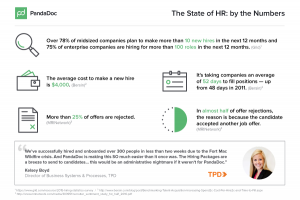The benefits of providing employee volunteering programs are endless. From keeping employees engaged and building camaraderie to improving corporate culture and employer brand, volunteer programs have the power to recharge and sustain a healthy workforce.
In 2016, CECP’s Giving in Numbers found that 61% of companies offer paid-release time volunteer programs, meaning employees are compensated for their volunteer time. If more employees were offered the chance to get out of the office, stretch their legs and do something meaningful that gives back to their community all while being paid for it, we think the world would be a lot better place!
We’ve compiled some of the best research-backed benefits to making the investment in volunteering programs for your organization. See them for yourself!
These benefits are easy to see, but if your current employee volunteer program is insufficient, they are hard to reap. If you are ready to provide a program that increases engagement, lowers stress and strengthens your entire workforce, employ these best practices.
Make it attractive to all employees: Variety is the spice of life and the main ingredient for program success. While some employees may enjoy getting their hands dirty by planting trees or building houses, others may prefer to donate their professional expertise through skills development pro bono programs. Make sure you offer programs for everyone to participate in, no matter their fitness or skill level.
Communicate across multiple channels: If you want employees to participate, you have to spread the word. Think about the various ways your employees can receive information and tailor your message to best suit those platforms. If the thought of managing email alerts, SMS text or internal group messages sounds daunting, consider CSR software to help coordinate your employees’ philanthropic goals.
Provide alternatives to the main focus: Not only is it important to provide variety in volunteer opportunities, but multiple dates and times are also beneficial to accommodate as many employee schedules as possible. Consider alternatives to volunteering time by allowing people to make monetary donations. Providing options for employees to contribute even if they can’t physically be there, or find the time in their schedule to volunteer, will maximize employee participation.
Make it mobile: Today’s workforce is spending less time chained to a desk and more time on the go. Employees are more apt to miss volunteer opportunities if they can only access communications from their work computer. Utilizing CSR software that is mobile-friendly can ensure that your program gains company-wide traction.
Today’s employees expect more out of their jobs than just collecting a paycheck. “They are not limiting their social consciousness to after work hours,” says Alison DaSilva, Executive Vice President of CR Research & Insights at Cone Communications. “[They] want their employers to give them opportunities to make a meaningful difference, whether that’s providing a platform for supporting personal issues or being an active participant in their company’s corporate responsibility efforts.” By providing employees with opportunities to volunteer time or treasure, they feel fulfilled at both a professional and personal level.
Employee volunteer programs not only lead to more invested employees and teams, but also help attract desirable candidates by improving your employer brand. Get started today and infuse excitement back into your workforce.
Digital & Social Articles on Business 2 Community(113)







